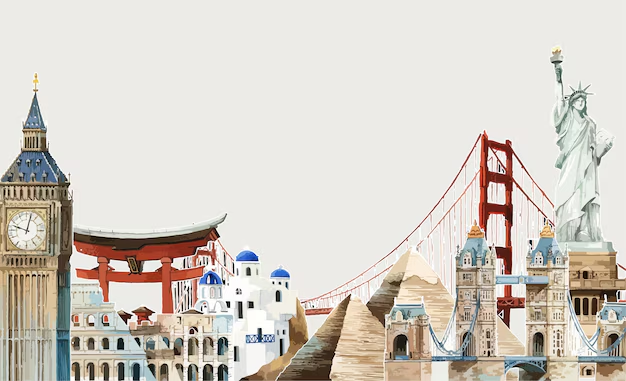Iconic Landmarks: The Intersection of Architecture and Culture
Iconic landmarks around the world serve as powerful symbols, representing both the architectural brilliance of their creators and the unique cultural identities of their locations. These landmarks often transcend their physical forms to become cultural symbols, histories etched in stone, and reflections of the values, aspirations, and creativity of the societies that built them. From ancient monuments to modern marvels, these structures tell compelling stories of the intersection between architecture and culture.
1. The Pyramids of Giza (Egypt)
The Pyramids are the epitome of ancient architectural achievement. The Great Pyramid of Giza, built around 2580 BC, stands as one of the Seven Wonders of the Ancient World. The Pyramids represent the ancient Egyptian understanding of the afterlife and their devotion to their pharaohs. As symbols of the civilization’s architectural and cultural prowess, the Pyramids continue to awe and inspire. Their massive scale, mathematical precision, and alignment with the stars speak to the Egyptians’ advanced knowledge of astronomy and engineering.
2. The Eiffel Tower (France)
Designed by Gustave Eiffel and completed in 1889 for the World’s Fair in Paris, the Eiffel Tower initially faced criticism for its unconventional design. Today, it is one of the most recognized structures globally, embodying both French engineering and innovation. The Eiffel Tower’s iron lattice structure was a daring departure from traditional building materials at the time and reflects France’s progressive spirit during the Industrial Revolution. Beyond its architectural significance, the Eiffel Tower symbolizes France’s artistic heritage, with its image often associated with romance, fashion, and sophistication.
3. The Great Wall of China (China)
The Great Wall is a complex series of fortifications built across northern China to protect against invasions from nomadic tribes. Its construction spanned over 2,000 years, evolving from simple earthen walls to sophisticated brick and stone fortresses. As a symbol of China’s historical resilience, the Great Wall is a cultural and architectural monument that conveys the collective efforts of the Chinese people in securing their civilization. The wall’s length and scale are testaments to the dedication and organizational power of various Chinese dynasties.
4. Taj Mahal (India)
Commissioned by Emperor Shah Jahan in the 17th century in memory of his beloved wife, Mumtaz Mahal, the Taj Mahal stands as a masterpiece of Mughal architecture. Its stunning white marble dome, intricate carvings, and lush gardens reflect both the grandeur of the Mughal Empire and the profound cultural importance of love and loss in Indian society. The Taj Mahal’s architectural beauty also draws from Persian, Ottoman, and Indian influences, symbolizing the cultural syncretism of the region.
5. Colosseum (Italy)
An enduring symbol of Ancient Rome, the Colosseum is a monumental amphitheater that hosted gladiatorial contests, public spectacles, and mock naval battles. Its engineering, particularly the use of arches and vaults, revolutionized the design of large public structures. The Colosseum is a stark reminder of Roman power and the empire’s ability to combine spectacle with architecture. It also represents a darker aspect of Roman culture, where public entertainment often involved brutality and death, reflecting the complex nature of Roman society.
6. Christ the Redeemer (Brazil)
Perched atop the Corcovado mountain in Rio de Janeiro, the Christ the Redeemer statue is both a religious symbol and a feat of modern engineering. Completed in 1931, it stands as a beacon of faith and a symbol of Brazilian culture. The statue’s location, facing the city below, represents the country’s Catholic roots while its open arms convey a message of peace and inclusivity. The design, blending art, engineering, and religious significance, connects the people of Brazil to their shared cultural identity and religious beliefs.
7. Sydney Opera House (Australia)
The Sydney Opera House, with its distinct sail-like design, is one of the most recognizable modern architectural landmarks in the world. Designed by Danish architect Jørn Utzon and completed in 1973, the Opera House reflects Australia’s cultural identity, symbolizing the country’s embrace of modernity and its strong connection to the arts. The building’s innovative design, blending architecture and acoustics, represents the artistic aspirations of the country while becoming an iconic global symbol for creativity and cultural expression.
8. Machu Picchu (Peru)
Machu Picchu, an ancient Incan city nestled high in the Andes, is a stunning example of Incan engineering and cultural heritage. Its terraced slopes, intricate stonework, and alignment with celestial bodies reflect the Inca’s deep understanding of astronomy and the natural world. As a symbol of Incan ingenuity and their complex society, Machu Picchu provides insight into a civilization that flourished before European colonization, offering a window into the cultural values and traditions that shaped the Inca Empire.
9. Petra (Jordan)
Petra, the ancient rock-cut city in Jordan, is a masterpiece of architectural innovation. The Nabateans carved intricate facades and tombs into the cliffs of red sandstone, demonstrating a profound connection to their environment. Petra’s architecture, with its monumental structures and water management systems, reflects the cultural and technological achievements of the Nabateans. The site is a symbol of the importance of trade, religion, and community in the ancient world, as it was a thriving hub along the spice and silk trade routes.
10. The Parthenon (Greece)
The Parthenon, a temple dedicated to the goddess Athena, stands as a symbol of Ancient Greece’s cultural and intellectual legacy. Its Doric columns and perfect proportions represent the pinnacle of Greek architectural achievement and their deep reverence for harmony and order. As a symbol of democracy, philosophy, and the arts, the Parthenon is central to Greece’s cultural identity and has influenced Western architecture for centuries.
Conclusion
These iconic landmarks are not just architectural feats; they are cultural touchstones, embodying the values, dreams, and histories of the societies that created them. They represent the fusion of artistry, engineering, and cultural significance, and in doing so, they continue to inspire and captivate us. As we gaze upon these monuments, we not only admire their beauty but also reflect on the shared human experience that transcends time and place.

